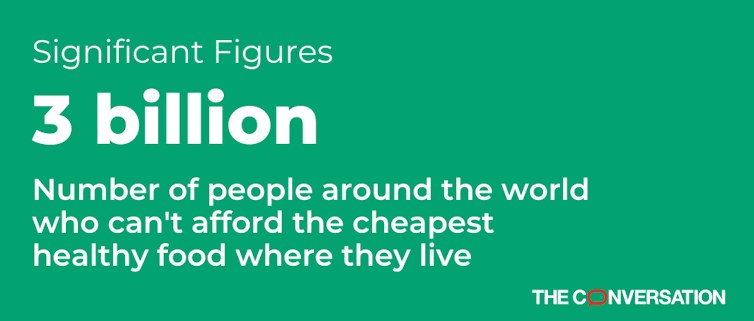3 billion men and women cannot find the money for a balanced diet plan

CC BY-ND
The COVID-19 pandemic has prompted price spikes for corn, milk, beans and other commodities, but even in advance of the pandemic about 3 billion individuals could not afford even the most inexpensive options for a nutritious diet.
The latest investigation of world wide food price tag knowledge reveals that as of 2017, the most up-to-date readily available year, all over 40% of the world’s inhabitants was already forced to consume poor-high quality diets by a mixture of large foodstuff charges and small incomes. When healthful goods are unaffordable, it is impossible for people to steer clear of malnutrition and diet plan-connected illnesses like anemia or diabetic issues.
The remaining 60% of the world’s 7.9 billion people today could pay for the components for balanced meals. That, of study course, does not indicate they normally consume a nutritious diet program. Cooking time and problem, as properly as the promotion and advertising of other food items, can guide quite a few men and women to opt for objects that are incredibly unhealthy.
Distinguishing among affordability and other results in of unhealthy meal plans is a vital step towards improved outcomes, produced attainable by a investigation job we are top at Tufts University referred to as Food stuff Selling prices for Nutrition. The project delivers a new watch of how agriculture and meals distribution relate to human wellness desires, connecting economics to nourishment in collaboration with the Globe Lender growth facts team and the Global Food Plan Investigation Institute.
To evaluate diet regime fees globally, our challenge connected Earth Financial institution cost information for about 800 preferred foodstuff across 174 nations around the world to the dietary composition of these products. Making use of the charges and dietary values of every merchandise, we computed the minimum costly way of assembly national dietary pointers and important nutrient needs.
For affordability, we when compared food plan charges to World Financial institution estimates of what men and women usually spend on food and profits distribution inside of each and every state. It turns out that practically absolutely everyone in the United States could pay for enough elements for wholesome meals, such as rice and beans, frozen spinach and canned tuna, bread and peanut butter and milk. But most people today in Africa and South Asia could not get more than enough of these food items for a healthier diet program even if they had been eager to expend their overall offered income.
Foods rates go up and down, but several balanced foods like fruits and greens, nuts, dairy solutions and fish are regularly far more high priced than starchy staples, oil and sugar. The substantial price tag of the healthier foods teams usually forces people in poverty to take in much less costly items, or go hungry.
What can be done?
Nations can make it feasible for everybody to find the money for a healthful eating plan by producing additional better-wage careers and by increasing social protections for small-revenue individuals. For example, the U.S. has the Supplemental Nourishment Guidance Software, or SNAP, which aids low-money Individuals invest in some of the foods they need to have. Basic safety internet programs of this form reduce foodstuff insecurity, defend work opportunities through downturns and are primarily vital for boy or girl development.
Outside of increased incomes and security nets for the poorest, food items price ranges can be reduced for everyone as a result of community financial investment in new engineering and infrastructure to strengthen foodstuff production and distribution. Agricultural innovation and expenditure in meals markets can preserve lives and drive financial growth – when the new systems and other variations are well tailored to community conditions.
[Like what you’ve read? Want more? Sign up for The Conversation’s daily newsletter.]
We feel that our diet program cost knowledge, developed to advise world agricultural procedures, provides individuals sharp new perception into the world food stuff problem. Past initiatives to observe world wide food stuff rates centered on monitoring a few internationally traded farm commodities, checking ailments in spots at hazard of famine or maintaining an eye on consumer rate indices. Measuring the value of healthful diet plans working with locally accessible goods focuses interest on consumer prices for the healthful foods that lower-earnings people today might invest in, if those people merchandise had been affordable.
With greater facts, governments and progress agencies can steer their nations to wherever they want to go, which one working day could make it feasible for all people around the earth to take in a healthier diet plan.
Globe Lender economist Yan Bai contributed to this investigate.








